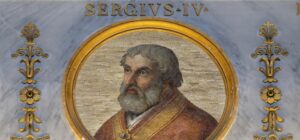 Sergius is the pope who made the taking of another name common among popes. He was born Peter, son of Peter the Shoemaker and his spouse Stephanie. Apparently, he was referred to as Peter Pig Snout.
Young Peter was born around 970 and grew up in the Pina area of Rome, not too far from the Pantheon. Someone saw intelligence in the face of the shoemaker’s son. He was educated and joined the Benedictine Order. Over time, he moved up the ranks of the clergy. In 1004, Peter was consecrated bishop of Albano, a town not too far from Rome.
When Pope John XVIII abdicated in early July 1009, Bishop Peter was nominated and elected by the end of the month. He took the name of Sergius, so as not to dishonor the name of the Apostle and martyr.
Sergius is the pope who made the taking of another name common among popes. He was born Peter, son of Peter the Shoemaker and his spouse Stephanie. Apparently, he was referred to as Peter Pig Snout.
Young Peter was born around 970 and grew up in the Pina area of Rome, not too far from the Pantheon. Someone saw intelligence in the face of the shoemaker’s son. He was educated and joined the Benedictine Order. Over time, he moved up the ranks of the clergy. In 1004, Peter was consecrated bishop of Albano, a town not too far from Rome.
When Pope John XVIII abdicated in early July 1009, Bishop Peter was nominated and elected by the end of the month. He took the name of Sergius, so as not to dishonor the name of the Apostle and martyr.
John Crescentius III was still the dictator of Rome and its environs. His purpose seemed to be to control all and steal as much as possible. The poor of Rome suffered as much from the rule of this man as from the frequent famines, the last large one only three years previous. As much as possible, Sergius tried to check the power of Crescentius by strengthening the imperial party, which favored the German Holy Roman Emperors. The counts of Tusculum were of this party. Unknown, apparently, to Sergius, the rise of this party would be a bigger upset than the work of the Crescentii.
While unable to have much temporal power, Sergius was able to have some ecclesiastical power. He exempted several monasteries and churches from overbearing episcopal jurisdiction. Many bishops were noblemen and had a sense of power that outweighed their spiritual bounds. Sergius tried to control that in a number of different places, making elections of abbots, visitations of prelates and other local concerns within the purview of the individual monastery or church.
Although the last large-scale famine was over, localized famines due to overuse of land, lack of farmers or other concerns, continued. Sergius was very generous in his help to the poor throughout his reign.
The most fascinating occurrence during his reign was the total destruction of the Church of the Holy Sepulchre, in Jerusalem, on 18 October 1009. The Fatimid Caliph al-Hakim bi-Amr Allah ordered the complete ruin of the church as part of a general plan to destroy Christian places of worship in Palestine and Egypt. Some said that the Jews instigated this to rid the area of Christians. Some said that al-Hakim did it to prove that he was not a Christian like his mother. At any rate, a papal bull, written by Sergius, calling for Muslims to be driven from the Holy Land turned up later. To this day, it is not known if it was authentically written at this time, or a forgery.
A story is prevalent that a famous noble, Fulk of Anjou, had John Crescentius killed, with the blessing of the pope. It sounds a little presumptuous, but we don’t know the truth. However, Crescentius did die during Sergius’ reign. Sergius died within days. Some say he was poisoned because, although the pope did work behind the dictator’s back to support the Holy Roman Emperor, in public, he was a puppet. Once the dictator died, his puppets would certainly go down in short order.
Sergius died 12 May 1012, aged about 52. He was buried in the Lateran Basilica, to the left of the entrance, according to John the Deacon. He was never canonized, but the Benedictines honor his feast day.

Recent Comments